Introduction
Front
{{section_header}}{{section.name}}{{/section_header}}
The front of the Panasonic TC-P42X3 is a black, high-gloss plastic with no features worth noting aside from a small power indicator light.

Back
{{section_header}}{{section.name}}{{/section_header}}
On the back of the Panasonic TC-P42X3 is where most of the ports are located. The plasma screen is protected by a robust metal backing, with no frills.

Sides
{{section_header}}{{section.name}}{{/section_header}}
The left side of the TV set contains the manual controls and the external media ports (2 USB ports and one SD/SDHC card slot). Also included on the same side is quite possibly the ugliest labeling for each of the ports and manual controls we've ever seen.

Stand/Mount
{{section_header}}{{section.name}}{{/section_header}}
The stand of the Panasonic TC-P42X3 is a square, high-gloss black that doesn't swivel. It has to carry a fairly hefty load, so it's understandable that Panasonic chose not to include this feature, but it still makes access to ports a hassle. This is not helped by the weight of the TV itself.

Controls
{{section_header}}{{section.name}}{{/section_header}}
Like we mentioned before, the manual controls of the Panasonic TC-P42X3 have a really ugly labeling, as well as a terrible layout. Why on earth the buttons are located on the same panel as input ports we'll never know, but the very least Panasonic could have done is put them on the other side of the set like they've done in their LCD models.

Remote Control
{{section_header}}{{section.name}}{{/section_header}}
The Panasonic TC-P42X3's remote is identical in every way to the remote of the 2011 model year Panasonic TC-P42X3, and other lower-end 2010 model year Panasonic TV sets. The remote itself is a matte black with black rubber buttons that are large and impossible to misread. While the remote is quite basic and easy to navigate, it is has awful key travel, meaning that you have to push down far on the buttons in order to operate the remote. This slows down operation of the remote significantly.

In the Box
{{section_header}}{{section.name}}{{/section_header}}
Included in the packaging for the Panasonic TC-P42X3 is a remote, stand, instruction manual and batteries.
Black Level
{{section_header}}{{section.name}}{{/section_header}}
Keeping consistent with Panasonic's good test results with their plasma TVs, the TC-P42X3 doesn't disappoint in this category, recording a deepest black of 0.05 cd/m 2. Keep in mind, that this reading is an averaged recording, and at many points in our black and white testing, we saw the reading dip below 0.02cd/m2. The TC-P42X3 consequently scored well in this area. More on how we test black level.
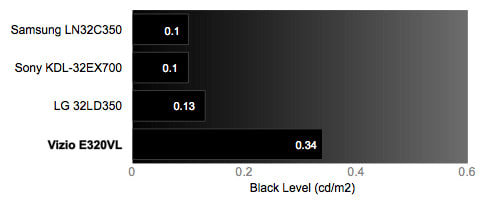
Peak Brightness
{{section_header}}{{section.name}}{{/section_header}}
This one's a bit tricky, as the TC-P42X3 tends to dim the screen the more white area is on it, so the peak brightness recording you see here does not come from a 100% white screen. Still, it's worth mentioning that Panasonic managed to give this set an improved peak brightness (138.13 cd/m 2) over some of their other 2011 plasma TVs like the TC-P50ST30 (which recorded about 100 cd/m 2). It still isn't anything to write home about, and due to the struggles with peak brightness in addition to an absurdly reflective screen you will probably have some difficulties watching daytime TV, but plasmas typically have troubles in this area due to the very nature of their technology.
For those of you unfamiliar with this, the way plasma screens work is very different from that of an LCD screen, and makes them prone to overheating while displaying certain colors that raise the temperature of the unit to a dangerous level (white being among the worst for this). Though it can be annoying that plasma screens can't get very bright, it's a safety issue. Panasonic is doing a good job in pushing the envelope for plasmas to reach that magical 200cd/m 2^ level where daytime viewing is watchable. More on how we test peak brightness.
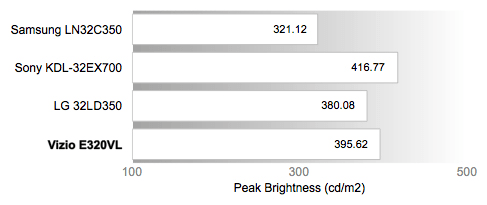
Contrast
{{section_header}}{{section.name}}{{/section_header}}
The Panasonic TC-P42X3 has a fairly good contrast ratio as a result of it's low black level and its high peak brightness (for a plasma). The contrast ratio of 2762:1 put it ahead of many other plasmas, but still not quite as good as the high-end plasma screens we've seen from Panasonic this year. More on how we test contrast.

Tunnel Contrast
{{section_header}}{{section.name}}{{/section_header}}
The Panasonic TC-P42X3 had some trouble maintaining a consistent black level depending on how much white was on the screen. This is fairly common with plasma screens, but in all fairness, the TC-P42X3 did fairly well if you consider that most plasma screens tend to have much more trouble over the entire range of our measurements. More on how we test tunnel contrast.
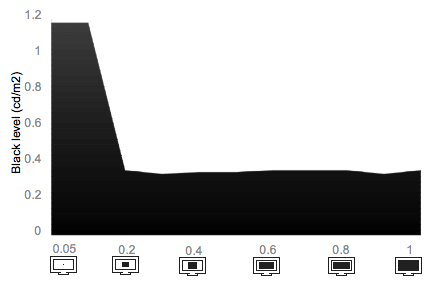
White Falloff
{{section_header}}{{section.name}}{{/section_header}}
All things considered, the TC-P42X3 didn't do too well in maintaining a consistent white level, showing a few hiccups along the graph, indicative of shifts in brightness levels as the area of black color increased on the screen. More on how we test white falloff.
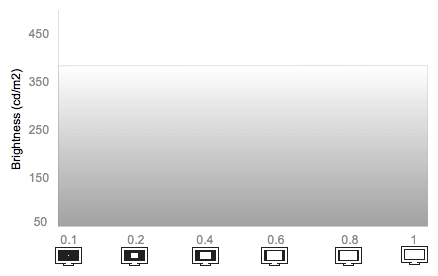
Uniformity
Greyscale Gamma
{{section_header}}{{section.name}}{{/section_header}}
Greyscale gamma is the measure by which we can see how well a TV set transitions from black to white. As you can see from the chart below, the Panasonic TC-P42X3 didn't do so well with this transition. When we score these measurements, we look at two main things: the slope of the line and whether or not there were any jagged sections of the chart that indicate an inability of the TV to display certain shades along the greyscale.
The slope of the line was 2.56, which is well outside the ideal range of 2.1 to 2.2. This isn't a terrible score, but we've seen better. What is most concerning is the steep incline in the middle of the chart and the inexplicable dip towards the end. What this tells us is that at a certain point, the TC-P42X3 will ramp up the rate it increases brightness drastically and then have a short range where it simply can't display the correct greyscale values. More on how we test greyscale gamma.
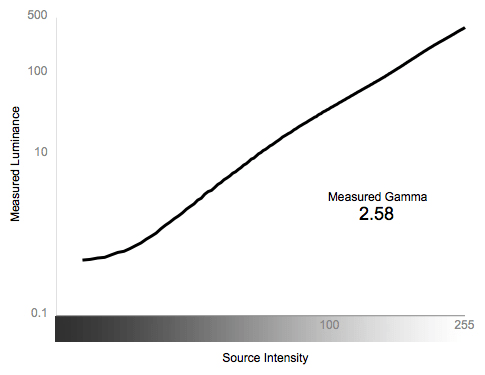
Color Temperature
{{section_header}}{{section.name}}{{/section_header}}
As you can see from the chart below, the Panasonic TC-P42X3 performed very well in terms of color temperature error, only displaying a perceptible shift in color temperature in very few ranges of signal intensity. More on how we test color temperature.

RGB Curves
{{section_header}}{{section.name}}{{/section_header}}
The RGB curves of the Panasonic TC-P42X3 are just plain bizarre, but we'll get to that in a minute. Remember the weird slope increase in the greyscale gamma chart Well, this is one of the consequences of that sort of issue; the RGB performance suffers and suffers greatly. You'll notice that there's an area in each of the color curves that reflects the steep climb in color value in relation to signal intensity, which means that shades of color will appear at an incorrect value in certain shades, and it will be noticeable. While you probably won't notice any color banding, the Panasonic TC-P42X3's performance in this area is lacking.
You'll notice that at the far right of the graph the color lines drop off significantly before they reach 100%. We tested each color value not once, not twice, but six times with our meter and got the same result every time. On the seventh test, we manually adjusted the last few color values to make sure there wasn't a problem with our test scripts, and lo and behold: the TV actually does drop color luminance at the brightest values. This is something that we haven't really seen before; we're used to peaking, we're used to seeing curves that fall short, but we're not used to seeing television sets that simply won't display the brightest color values even though we know it can. What does this mean for you? Well, when you're watching anything on your Panasonic TC-P42X3, you'll notice that the brightest colors are a fair bit darker than what they should be, and colors that should be a little bit darker are brighter than the normally brightest ones. More on how we test RGB curves.

Below is a linear representation of the transition of each color displayed by the comparison model TVs versus the ideal response and that of the Panasonic TC-P42X3.
Motion Performance
{{section_header}}{{section.name}}{{/section_header}}
Though plasma screens have a naturally high refresh rate due to the nature of their design, the Panasonic TC-P42X3 has average motion performance at best. While performing our tests, we noticed that the processor had trouble handling motion in general, displaying skewed images, a fair amount of artifacting and false color trails. More on how we test motion performance.
3:2 Pulldown & 24fps
{{section_header}}{{section.name}}{{/section_header}}
The standard 3:2 pulldown video processing feature did a fair job helping the Panasonic TC-P42X3 deal with motion in film content, but it still struggled a bit with high-frequency patterns. Though there are three settings, film content seems to work better when you take the Panasonic TC-P42X3's 3:2 pulldown setting out of "Auto" and put into "On," as it seems to have trouble detecting film content at times. More on how we test 3:2 pulldown and 24fps.
Resolution Scaling
{{section_header}}{{section.name}}{{/section_header}}
The Panasonic TC-P42X3 really did not handle our resolution scaling tests all that well. On top of a seeming inability to display a signal with accurate scaling, there was Moiré interference where there usually is none even in lower-end TV sets, even in its native resolution. More on how we test resolution scaling.
480p
In the 480p resolution, the TC-P42X3 lost 2% of the screen area to vertical overscan and 3% to horizontal overscan. It also had trouble with high-frequency patterns.
720p
Here, the TC-P42X3 lost 2% of its image to vertical overscan and 3% to horizontal overscan. It absolutely dropped the ball on high-frequency patterns, showing a considerably high amount of Moiré interference.
1080i
The TC-P42X3 has a native resolution of 720p, so this resolution scaling is never really going to be handled all that well. Still, it lost the same 2% to vertical overscan and 3% to horizontal overscan, as well as being almost unable to handle our other resolution tests at all.
Formats
{{section_header}}{{section.name}}{{/section_header}}
The Panasonic TC-P42X3 has a native resolution of 720p and can display all standard NTSC resolutions, but it can only handle 720p and below well. Anything higher than that and you're asking for poor picture quality.
Viewing Angle
{{section_header}}{{section.name}}{{/section_header}}
Like most plasma screens, the Panasonic TC-P42X3 has an extremely wide viewing angle, just over 70 degrees from center on either side. Beyond this point, the picture loses half of its contrast, but in reality, seeing a severely skewed and crunched picture would probably be your main concern if you were viewing at such an extreme angle. This TV is great for having multiple guests over to watch.

Reflectance
{{section_header}}{{section.name}}{{/section_header}}
Like many other plasmas, this TV's screen is extremely reflective. We expect this to be more or less the case for most plasma screens, but it's still annoying; in a well lit room you are likely to see your own reflection at some points, or during advertisement transitions. Should there be a light shining on the screen, you will be almost unable to ignore it.
Video Processing
{{section_header}}{{section.name}}{{/section_header}}
The Panasonic TC-P42X3 has a litany of extra video processing features, some more effective than others.
Calibration
{{section_header}}{{section.name}}{{/section_header}}
Using Cinema mode as a starting point, we calibrated the Panasonic TC-P42X3 to maximize its performance and give it the best possible shot in our tests. There weren't any problems in calibration that we ran into, and the interface is intuitive and simple. However, it is not always possible to turn every video processing feature off depending on what type of source you have connected to the TV via the HDMI cable. Below is our calibration of the TC-P42X3.

All of our calibration is done in conjunction with the DisplayMate software.
](http://www.displaymate.com/)
Video Modes
{{section_header}}{{section.name}}{{/section_header}}
The Panasonic TC-P42X3 has several picture modes, each more suited for a certain viewing environment than another.
Connectivity
{{section_header}}{{section.name}}{{/section_header}}
The Panasonic TC-P42X3 has a reduced number of ports, but this isn't exactly surprising to us, as many manufacturers have started to eschew legacy analog input and output ports in favor of having more HDMI ports and internet connectivity. Still, some users may find this to be a shortcoming if they use several analog external media sources.

On the side of the TC-P42X3 are 2 USB input ports, as well as an SD/SDHC card slot for external media.
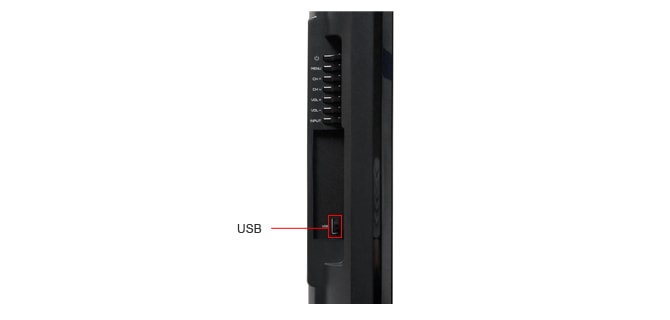
Below, you'll see how the Panasonic TC-P42X3 stacks up against the competition in terms of connectivity.
{{product.manufacturer_specs['Connectivity Tour Image 3']}}
Placement
{{section_header}}{{section.name}}{{/section_header}}
There isn't much one could do to mess up placement of so few ports, but there are definite improvements Panasonic could make in this area. Namely, they could return to their normal convention of not combining button and port panels. Another problem you will notice right away is the natural consequence of having a plasma TV on a stand that can't swivel: it's hard to reach the rear port panel, and the much heavier plasma screen makes moving the set difficult.
Audio Quality
{{section_header}}{{section.name}}{{/section_header}}
Surprisingly enough, the Panasonic TC-P42X3 actually had a fairly decent audio performance. Sporting two 20 watt speakers, the TV isn't going to trick anybody into thinking you have a surround sound system, but you will feel some bass in loud scenes with the TC-P42X3's surround mode turned on. Unfortunately, there is no true equalizer, but this seems to be the norm in low-end TVs.
Menu Interface
{{section_header}}{{section.name}}{{/section_header}}
Panasonic has not changed the menu interface much, keeping the same look, feel and most of the options consistent with their TVs over the 2010 and 2011 model years. That's not to say that it's a bad interface, but it's a very basic and unappealing one. The main menu is still the same collection of applications on the bottom of your screen, though you can tell it was intended for a 1080p screen, as there's a bunch of picture quality loss when an icon isn't selected.

The settings menus are the same as what Panasonic put on all its other TVs in 2011: utilitarian, but painfully basic.
The external media menus are the same as the ones on the other 2011 Panasonic TVs, which are easy to use, but are ugly as sin.

Instruction Manual
{{section_header}}{{section.name}}{{/section_header}}
Like many of its other instruction manuals, Panasonic has done a great job with making sure you'll be able to find any information you might need in normal operation of your TV set. The tabbed browsing and complete index and table of contents make location of information easy, and many clear pictures and diagrams make deciphering what you need to do a simple job. You can find the Panasonic TC-P42X3's manual online here.

A manual for so many TV models, they have to be further categorized by type.
Internet Features
{{section_header}}{{section.name}}{{/section_header}}
The Panasonic TC-P42X3 has a handful of pre-loaded internet applications, some you will find more useful than others. Panasonic does seem to have a bunch of Yahoo! applications, and as long as that partnership sticks around, you should be able to download content from Yahoo! as it becomes available. Netflix, Amazon and Pandora also have apps on the TC-P42X3, so if you have accounts with those services, you can stream content to your Panasonic!
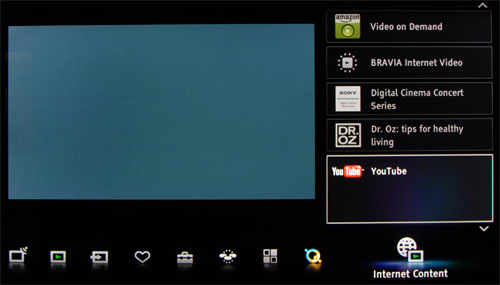
Local Media Playback
{{section_header}}{{section.name}}{{/section_header}}
If you'd like to play your own media on the Panasonic TC-P42X3, you can simply load your video, music or photo files onto a USB drive or SD/SDHC card and plug it directly into the side of the TV. Be aware that the only video files supported by the TC-P42X3 are of a fairly uncommon file type, and photo and music files are only allowed to be .jpg and .mp3 respectively.
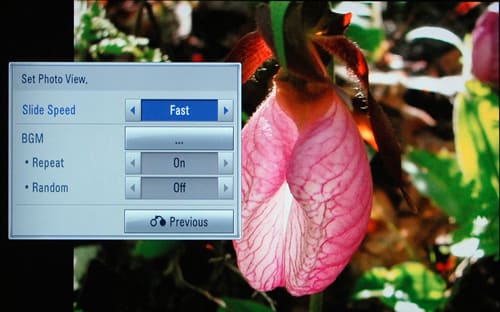
Music playback takes up the entire screen, so don't plan on using your own files to back up slideshows. Still, the playback animation isn't unattractive.
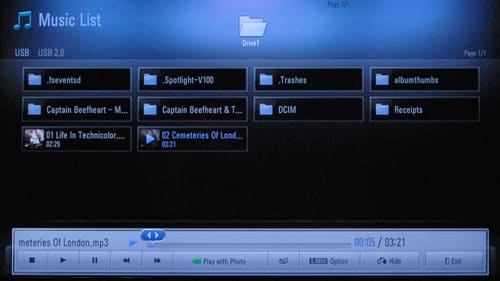
Other Media
{{section_header}}{{section.name}}{{/section_header}}
The Panasonic TC-P42X3 does not support any other type of media.
Power Consumption
{{section_header}}{{section.name}}{{/section_header}}
For a plasma TV, the Panasonic TC-P42X3 really does not hog much current. While you won't see a dramatic drop in your power bill, over time you will save a bit of money if you are dead-set on getting a plasma screen. Keep in mind, though, that LCD TVs almost always draw less power than plasma screens, as you can see in the table and charts below.
As the graph below indicates, the Panasonic TC-P42X3 does pretty well against its competition: it's estimated to cost less than half of what it would to power the Samsung PN50C550, and even less than one of its predecessors. It still costs more than most LCD screens to power, but that's not surprising given the screen type.
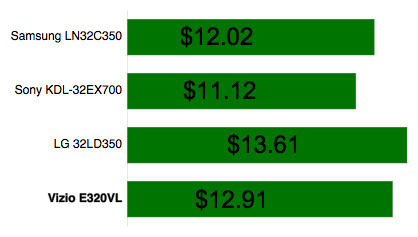
Value Comparison
{{section_header}}{{section.name}}{{/section_header}}
Even though the PN50C550 has a higher MSRP, at this point in its life cycle you can probably find it for cheaper online. Overall, you will get much more bang for your buck with the PN50C550 with many more ports, features and a bigger screen area. Performance-wise there isn't much difference between the two sets outside of power consumption, which the Samsung requires more than double the current that the TC-P42X3 draws. If that's a sticking point for you, you may be better off with the Panasonic.
Blacks & Whites
{{section_header}}{{section.name}}{{/section_header}}
Both the Samsung PN50C550 and the Panasonic TC-P42X3 have comparably low black levels, but where the Samsung sets itself apart from the other plasma screens is peak brightness. It's still not above 200 cd/m2, but it's closer than the TC-P42X3. Both sets are very close in their contrast ratio.

Color Accuracy
{{section_header}}{{section.name}}{{/section_header}}
Even though neither TV set had much difficulty with color temperature error, the TC-P42X3 displayed less total perceptible error than the PN50C550. Still, you will probably not even notice the error in color temperature on either set. In terms of RGB curve, both sets are disappointing in their final score. As you can see from the color strips below, both TV sets have issues with color banding.
Motion
{{section_header}}{{section.name}}{{/section_header}}
Both the Samsung PN50C550 and the Panasonic TC-P42X3 had more or less average motion scores, meaning that although they weren't egregiously bad, they still have somewhat minor, but noticeable issues handling motion in their picture.
Viewing Effects
{{section_header}}{{section.name}}{{/section_header}}
As you can see from the chart below, neither TV set had a clear advantage over the other in terms of viewing angle. Plasmas typically have huge viewing angles, so this comes as no surprise.
Connectivity
{{section_header}}{{section.name}}{{/section_header}}
The Panasonic TC-P42X3 has a reduced number of ports on the back, eschewing legacy analog ports for internet content, while the Samsung PN50C550 has a few more analog options.
Value Comparison
{{section_header}}{{section.name}}{{/section_header}}
Even though the TC-P42GT25 has a much higher MSRP, at this point in its life cycle you can probably find it online for less than the posted $1699. In terms of performance, the TC-P42X3 is comparable in most areas to the TC-P42GT25, but the TC-P42GT25 offers much more in the way of connectivity options and sports a better color performance, on top of the option to display 3D content, should that be important to you.
Blacks & Whites
{{section_header}}{{section.name}}{{/section_header}}
The TC-P42X3 is the clear winner here, measuring a lower deepest black and better contrast ratio. One of the major flaws of the TC-P42GT25 is the unusually low brightness level. Although the TC-P42X3's peak white isn't drastically better, it is much better suited for a broader range of viewing situation, as the TC-P42GT25 will struggle to display a picture that can still be seen in a well-lit room. This itself may be enough to tip the scales in the TC-P42X3's favor.

Color Accuracy
{{section_header}}{{section.name}}{{/section_header}}
Neither TV displays much color temperature error, and certainly not much within the realm of human perceptibility. While the TC-P42X3 scored marginally better in the color temperature error metric, it fell far short in terms of RGB performance, as you can see some color banding in the color strips below, where the TC-P42GT25 has almost no problem in this area.
Motion
{{section_header}}{{section.name}}{{/section_header}}
Neither TV was anything to write home about in terms of motion performance, but they were anything but bad. Each has a comparable score to the other, with only a slight edge given to the TC-P42GT25.
Viewing Effects
{{section_header}}{{section.name}}{{/section_header}}
Despite the difference in score, both the TC-P42X3 and the TC-P42GT25 have virtually identical viewing angles. Because each TV has a plasma screen, the viewing angle is quite large on both sets, and you really can't go wrong with either on this.
Connectivity
{{section_header}}{{section.name}}{{/section_header}}
Where the TC-P42GT25 really sets itself apart from the TC-P42X3 is connectivity options. As you can see in the chart below, if the TC-P42X3 has it, the TC-P42GT25 has more of it. Analog options, digital options, internet connectivity, you name it; the TC-P42GT25 is better equipped to handle multiple external media sources than the TC-P42X3.
Other Comparisons
{{section_header}}{{section.name}}{{/section_header}}
The TC-P42GT25 is capable of displaying content in 3D, where the TC-P42X3 is not. Still, because it's a first-gen 3D TV it's not going to dazzle you, as even the latest-and-greatest 3D TVs leave something to be desired in the way they handle 3D content.
Value Comparison
{{section_header}}{{section.name}}{{/section_header}}
The Vizio E321VL has an LCD screen, which brings with it certain advantages and disadvantages to the plasma-screened Panasonic TC-P42GT25. Chief among these tradeoffs: it has better power consumption, but a much worse viewing angle. With the lower MSRP, you're getting less screen area, roughly the same connectivity options and a much reduced contrast ratio.
Blacks & Whites
{{section_header}}{{section.name}}{{/section_header}}
The Vizio E321VL holds only one slight advantage over the TC-P42X3 in the blacks and whites category: better peak white. Usually, in order to view content in a well-lit room, you will need at least 200 cd/m2^ to view your programs without much difficulty. Because the TC-P42X3 has a highly-reflective screen and a peak white below 200 cd/m2, such a viewing environment can be problematic, where the Vizio won't have the same difficulties, even though its black and white performance is much worse than that of the TC-P42X3.

Color Accuracy
{{section_header}}{{section.name}}{{/section_header}}
Both TV sets had virtually identical color temperature error performances in our tests, with very little if anything in the way of perceptible color temp error. The Vizio E321VL did, however, do quite a bit better in the RGB portion of our tests, showing much less color banding in our color strips, meaning it does not have the same problem with posterization that the TC-P42X3 might have with certain colors in shadows.
Motion
{{section_header}}{{section.name}}{{/section_header}}
Even though the TC-P42X3's motion performance is nothing to write home about, that of the Vizio E321VL's motion performance is just abysmal. If you're looking for a cleaner picture in motion, the Panasonic TC-P42X3 is the clear winner here.
Viewing Effects
{{section_header}}{{section.name}}{{/section_header}}
Much like most LCD screens, the viewing angle of the Vizio E321VL simply cannot compare to that of a plasma screen. While it's actually quite good for an LCD TV, the viewing angle of the E321VL will not be able to accommodate a large group of people as well as any of the other plasma-screened comparison models.
Connectivity
{{section_header}}{{section.name}}{{/section_header}}
Neither TV set has much in the way of connectivity options, but the Vizio E321VL has a headphone jack and a VGA input port. Both sets have internet connectivity, but the TC-P42X3 can be upgraded to handle wireless via a separate purchase.
Conclusion
The Panasonic TC-P42X3 is a fairly budget buy for a 2011 plasma TV. It doesn't have many high-end features, nor does it even have a native 1080p resolution. Still, it offers decent performance at a price that won't break the bank.
While it doesn't lag too far behind competitive model televisions, it doesn't have the same analog connectivity options, which seems to be the trend for newer TV sets. Panasonic does do a good job with giving the entry-level TC-P42X3 some advantages over higher-priced models, like improved picture performance and reduced power consumption.
Overall, the TC-P42X3 won't disappoint if you're looking for a more affordable plasma screen, as long as you are aware of the benefits and pitfalls of owning a plasma screen TV. That being said, the color performance is simply bizarre, and it will be a bit distracting when watching your favorite movies or TV shows. If you're looking for picture quality or high-performance, you might consider looking elsewhere.
Model Series Comparison
{{section_header}}{{section.name}}{{/section_header}}
The Panasonic TC-PxxX3 series has three TVs: the TC-P42X3, the TC-P46X3 and the TC-P50X3. All three are plasma-screened television sets, and all three have a native resolution of 720p.
Photo Gallery
{{photo_gallery "Front Tour Image", "Back Tour Image", "Sides Tour Image", "Stand Photo", "Controls Photo", "Remote Control Photo", "Connectivity Tour Image 1", "Connectivity Tour Image 2", "Connectivity Extra Photo", "Menu Main Photo", "Menu 2 Photo", "Internet Features 1 Photo", "Internet Features 2 Photo", "Internet Features 3 Photo", "Local Media Playback 1 Photo", "Local Media Playback 2 Photo"}}
Ratings & Specs
{{manufacturer_specs_table}}
Meet the tester
A seasoned writer and professional photographer, Chris reviews cameras, headphones, smartphones, laptops, and lenses. Educated in Political Science and Linguistics, Chris can often be found building a robot army, snowboarding, or getting ink.
Checking our work.
Our team is here for one purpose: to help you buy the best stuff and love what you own. Our writers, editors, and lab technicians obsess over the products we cover to make sure you're confident and satisfied. Have a different opinion about something we recommend? Email us and we'll compare notes.
Shoot us an email
